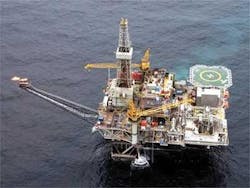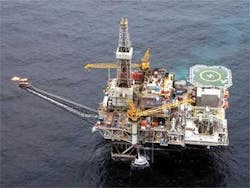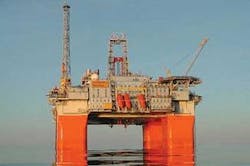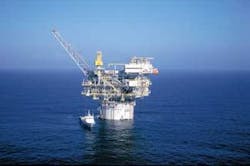OTC 2008 preview – Waves of change
Pam Boschee, Special Correspondent
With oil moving at more than $100/bbl and global demand showing no signs of abating, OTC’s attendance this year most likely will break another record.
Last year’s attendance topped 67,000, an increase of more than 13% over 2006. Expect this year’s program to set a new high during May 5-8 in Houston. Reflecting industry interest, the technical program has been expanded to include Thursday afternoon to deliver more information.
OTC offers attendees the opportunity to learn about new technologies in geoscience, deepwater methods and equipment, industry trends, and more.
Following are samples of the technical program and special events. Session descriptions are not all-inclusive; check OTC’s technical program for complete details and schedule.
Maximize recovery, minimize costs
Continued growing demand for oil drives technology and efforts to maximize recovery.
The technical program kicks off with a panel on Monday, May 5, to discuss methods to keep production costs low while aiming for high-cost resources.
A range of subjects related to managing offshore project risk will be addressed in a Monday afternoon panel session. Risk engineering in the GoM, international risk management, and financing new technologies and managing financial risks are among the topics to be covered.
Increased oil recovery will be the subject of a Monday afternoon session. StatoilHydro will discuss its IOR program, as well as the future drilling scenario, trend-breaking completion/intervention methods, and technology for increased recovery.
Field experiences will drive discussions of chemical sand consolidation, seabed processing at Tordis, and riserless light-well intervention.
The general session on Tuesday, May 6, in the afternoon will feature OPEC’s view of petroleum as the energy of the future. On Wednesday afternoon, the general session is scheduled to offer a global energy outlook, emphasizing challenges such as enhanced oil recovery and reduced costs, governmental energy policy, labor, and environmental concerns.
Compliance with global environmental and climate regulations contributes to the costs of projects. Several sessions address these challenges and the technologies evolving to meet them.
Tuesday morning’s panel session tackles the subject of achieving a balance between energy security and climate security. In the afternoon, a session will explore CO2 issues and methods of control. Highlighted topics include:
- Trapping CO2 in saline aquifers and depleted hydrocarbon reservoirs
- Monitoring strategy for CO2 sequestration regulatory management
- Carbon storage in deepsea sediments
- Imaging for monitoring CO2 storage in geological formations
- Seismic modeling of CO2 saturation for sequestration
- Subsurface CO2 storage capacity calculations.
Carbon dioxide sequestration will be discussed Tuesday afternoon, as well.
Alternative energy sources will be addressed on Thursday morning, May 8, in a session covering natural gas, tar sands, nuclear energy, wind, and tidal. The participants aim to highlight the relative advantages and disadvantages of each as well as the associated economic, political, and environmental issues.
Wednesday afternoon features a session on environmental constraints on deepwater wells and facilities. Developing improved bio-geology overviews, AUV and ROV data integration to identify environmentally sensitive deepwater areas, and modification of routine sampling methods are among the topics.
Project perspectives
Several sessions offer insights into milestone projects, including unique technologies and innovative recovery methods. Project-specific challenges and companies’ approaches to overcoming them are the focus of these presentations.
An overview of the Kikeh development, offshore Sabah, East Malaysia, will be presented on Tuesday morning.
Located in 1,340 m (4,400 ft) of water, the Kikeh discovery lies in the southern part of block K and is the first deepwater oil discovery made in Malaysia. First oil production began in August 2007.
Kikeh is developed as a stand-alone facility with production from both subsea and dry tree wells on board a spar facility. The oil is processed, stored, and exported from an FPSO.
Murphy Sabah Oil Co. will discuss the project’s execution model; spar topside floatover installation; design of the world’s first gravity actuated pipe fluid transfer system; and subsea equipment installation challenges.
Arctic offshore projects are the focus of a Tuesday afternoon session. Pioneer Natural Resources Co. will present overviews of its Oooguruk project, the first North Slope field operated by an independent oil company.
Pioneer expects first oil production from Oooguruk during the first half of 2008.
The company has recently signed a production processing and services agreement with the Kuparuk River Unit owners for processing and transport through the Trans Alaska Pipeline System.
Production is expected to peak during 2010 at 15,000 to 20,000 gross b/d of oil from approximately 40 development wells (approximately half of the wells will be producing wells and half will be injection wells).
Nabors Alaska Drilling will discuss a specialized AC-powered drilling rig for arctic offshore drilling; Coastal Frontiers Corp. will highlight how waves, ice, and river discharge affects the design of Arctic offshore production facilities. AKAC will address ice management with icebreakers, and Aker Kvaerner Pusnes will discuss offshore loading systems for arctic conditions.
Also on Tuesday afternoon, Petrobras will highlight its Roncador field development in the northern Campos basin, 125 km (78 mi) from Cabo de São Tomé.
Roncador holds the distinction of having the world’s first drill pipe riser, subsea tree, and early production riser rated for 2,012 m (6,600 ft).
This session will include an overview of the field’s development, reservoir aspects and well development strategy, challenges in flow assurance, and development of subsea facilities.
The most recent GoM lease sale in late March showed with its record-setting high bids how attractive this region remains to oil and gas companies. A panel of representatives from Devon Energy, Chevron, Shell, Anadarko, MMS, and BP will discuss GoM projects on Wednesday morning.
The Azeri-Chirag-Gunashli (ACG) field in the Azerbaijan sector of the Caspian Sea is the topic of a Wednesday afternoon session.
The ACG field lies 120 km (75 mi) off the coast of Azerbaijan in 120 m (394 ft) of water and contains 5.4 Bbbl of recoverable oil. Its fields include: Chirag, Central Azeri (CA), West Azeri (WA), East Azeri (EA), and Gunashli. Oil and gas is transported via the Baku-Tbilisi-Ceyhan (BTC) pipeline from the Caspian Sea to the Mediterranean.
Chirag has 21 wells in operation (14 oil producers and seven water injectors) and now is producing around 116,000 b/d. From the start of production in November 1997 to the end of 3Q 2007, Chirag had produced about 418.4 MMbbl of oil.
Central Azeri has 16 wells (12 oil producers and four gas injectors), currently producing around 280,000 b/d. From the start of production in February 2005 to the end of 3Q 2007, CA had produced over 191 MMbbl of oil.
West Azeri (WA) has 10 wells (eight oil producers and two water injectors), currently producing around 188,000 b/d. From the start of production in early January 2006 to the end of 3Q 2007, WA had produced about 81 MMbbl of oil.
East Azeri (EA) currently is producing around 136,000 b/d from seven producing wells. From the start of production in October 2006 to the end of 3Q 2007, EA had produced about 38 MMbbl of oil.
In late July 2007, the topsides of Phase 3 Drilling, Utilities, and Quarters Platform (DUQ) were installed onto the jacket in the deepwater Gunashli part of the ACG field. The DUQ platform is at 175 m (575 ft) water depth with first oil planned to be achieved during 2008. This will ultimately raise the ACG offshore facilities’ total oil production capacity to over 1 MMbbl/d.
BP is the operator and, along with KBR, will provide updates on topside and jacket design and fabrication, subsea water injection, onshore terminal expansion, marine delivery, and offshore platform temporary pin-pile foundations.
Canada’s East Coast leading edge R&D initiatives will be the subject of a Monday morning session. Produced-water discharge monitoring, using MRI to measure capillary pressure in petroleum reservoir test cores, mitigation of ice risk to subsea infrastructure, and evacuation training using immersive simulators will be among the topics discussed by speakers from the Memorial University of Newfoundland, University of New Brunswick, and C-Core. Small-field development and subsea tieback technologies will be presented by Canada Newfoundland Offshore Petroleum.
Riser technology
Advances in deepwater technology will be highlighted in many sessions. Steel catenary riser technology will be the topic of a Monday morning session. Coupled analysis methodology, umbilical stability analysis, SCR receptacles standardization, model tests for steel catenary risers in marine clay, and spectral and cycle-counting fatigue damage estimation methods will be discussed.
Flexible risers are the topic of a Monday afternoon session. Fatigue design with a nondry annulus environment, optical condition monitoring of flexible risers, development of the end-fitting-tensile-wires fatigue analysis model, and flow assurance and optimal design of thermal characteristics in flexible pipes are among the subjects to be discussed.
Technip and Chevron will present an Agbami case study showcasing flexible pipe design optimization for West Africa deepwater.
Agbami is Nigeria’s largest deepwater development and consists of 20 oil producers, 12 water injectors, and six gas injector wells.
Advances in deepwater steel catenary riser technology is the topic of a Monday morning session. Design based on prescribed motions from coupled analysis methodology; umbilical stability analysis; SCR receptacle standardization; model tests for steel catenary risers in marine clay; and spectral and cycle-counting fatigue damage estimation methods will be discussed.
Geophysics and monitoring
Worldwide advances in geotechnics will be highlighted in a Monday morning session:
- Quality Assessment of Marine Sediments Recovered with a Hydraulically Tethered Piston Sampler
- Characterization of Near-Seabed Surface Sediments
- Worldwide Advancements in Deepwater Geotechnics: SEPLAs as Permanent Preset Mooring for Field Development in Congested Fields Offshore West Africa
- Site Characterization through Integration of Geophysical and Geotechnical Data
- Design and Testing Out of Deepwater Seabed Sampler
- Characterization of Soft Deepwater West Africa Clays: SHANSEP Testing is Not Recommended for Sensitive Structured Clays
- Differences in Shear Strength Between Jumbo Piston Core and Conventional Rotary Core Samples.
Emerging geophysical technologies are the subject of a session on Wednesday morning. Reservoir monitoring with fiber optics, seismic monitoring on the Snorre field, permanently installed 4C fiber optic sensor cable, and optimum optical architectures are some of the subjects to be discussed.
The Lawrence Berkeley Laboratory will discuss acoustic signatures of crossflow behind casing for monitoring production in commingled reservoirs.
Advances in electromagnetics will be highlighted on Wednesday morning. Acoustic changes have driven seismic monitoring, which continues to be the workhorse for description of reservoir shape and stratigraphy. Electromagnetics offer a method to describe fluid properties as elastic waves travel through the rock matrix.
BP’s Egypt field trial will be among the topics presented in this session, discussing marine transient controlled-source electromagnetics.
The application of electromagnetic scanning to an Australian frontier basin with complex bathymetry will be presented by emgs, as will seabed logging survey design optimization using grid modeling.
OHM will discuss reservoir characterization through joint interpretation of electromagnetics, seismic, and well-log data.
GoM subsalt imaging through marine magnetotelluric data interpretation is the subject of a presentation by WesternGeco Electromagnetics.
High grading prospect portfolios using electromagnetics data is the topic of Shell International E&P’s presentation.
Use of electromagnetics technology in exploration decision-making will be discussed by Aker Exploration.
Geotechnical issues specific to risers and flowlines are the topics of interest in a Thursday morning session. Pipe/soil interaction with flowlines during lateral buckling and pipeline walking will kick off this session. Riser seafloor interactions will be discussed, as will soil interaction in plastic clays with flowlines and risers.
Interaction models for steel compliant risers on soft seabeds will be presented by Texas A&M University; DNV Energy will address riser seafloor interaction using explicit finite element methods.
Reassessment of P-Y curves for soft clays from centrifuge testing and finite element modeling will be discussed by BP and Sage USA.
Marine geohazards will be discussed in a Tuesday morning session. Topics will include reducing the effect of submarine debris flow on pipelines; measured swabbing pressures and implications for shallow gas blowout; geohazard assessment and avoidance on the GAZA marine subsea development; geohazards of the Woodside OceanWay LNG development, off southern California; North Falkland basin Palaeo mega furrows; and deepwater site investigation.
Marine gas hydrates
A Wednesday morning session takes a look at the geology of hydrates and resource assessment.
Global distribution and efforts to determine resource potential will take center stage.
The 2007 Report to Congress by the US Federal Methane Hydrate Advisory Committee will be highlighted by the Colorado School of Mines. The US Department of Energy will discuss the research path to determining the resource potential of marine gas hydrates.
Laboratory studies for hydrate property determination will be the subject of a session on Wednesday afternoon.
Gas production strategies and processes for hydrates will be covered in a Thursday afternoon session.
Production-related geomechanical and geophysical processes are the topics to be covered in a hydrate session on Thursday afternoon.
LNG transport, pipelines
A global LNG overview, including new designs, will be presented on Tuesday morning.
LNG imports into North America, terminal expansions, and critical parameters for LNG marine terminal site selection are among the subjects. Engineering considerations for offshore FSRU LNG receiving terminals, an update on LNG facility construction, and trends and technologies in LNG carriers and offshore LNG facilities will round out this session.
Modern LNG marine terminals will be discussed on Thursday morning.
Qualification of a flexible-hose-based LNG transfer system at the Gaz de France Montoir-de-Bretagne LNG terminal (Europe’s largest such facility) will be among the topics presented.
On Thursday afternoon, an LNG session will include topics such as heavy production platforms for offshore LNG development; collision protection for LNG carriers; an experimental study on the spreading of liquid nitrogen over water; and advanced LNG offshore design and operations, among others.
Ultra deepwater pipeline installations are the subjects of a session to be held on Thursday morning.
Topics such as strain criteria for deepwater pipe laying operations; limit state design of XHP/HT PiP flowlines; and jet-induced trenching operations are among the presentations.
Coiled tubing installation, 3D modeling for deepwater umbilical design, and evaluation of landslide impact on deepwater submarine pipelines also will be presented.
Another session dedicated to pipelines is set for Thursday afternoon.
Presentations will include experimental modeling of the unburial behavior of pipelines; pipeline floatation assessment in partially liquefied seabeds; and the design, fabrication, and installation of export lateral PLETs in the GoM.
Other GoM-related topics in this session will include deepwater pipeline repair capability and solutions to pipeline technology challenges.
Also included will be discussions about optimized pipeline routing and assessment of fitness for continued service of a hurricane-damaged export pipeline in 1,000 m (3,280 ft) of water.
Deepwater drilling, completions
A Monday morning session will discuss issues related to the selection of corrosion-resistant alloys and elastomers for deepwater completions. In the afternoon, production operations and interventions will be presented, including a discussion of downhole tool design for deepwater highly deviated wells. Isolation valve contingencies using wireline stroker and tractor technologies will also be discussed, as will a collaborative effort for repair of a gas well with solid expandable chrome liner.
HP/HT well completion technology is highlighted on Tuesday afternoon. Topics include development of a high-temperature rechargeable battery for downhole use; diagnosis of well performance degradation on HP/HT fields using only wellhead temperature measurements; titanium alloy tubing for HP/HT applications; effects of startup and shutdown of HP/HT wells on wellbore hydraulic control-line design; and real-time casing annulus pressure monitoring in a subsea HP/HT exploration well, among others.
Well completion equipment and methods will be discussed in a Thursday morning session, including case histories from the GoM and Campos basin. All-electric subsea tree system development will be presented by Statoil, and Halliburton will discuss a system level approach to subsea hydraulic control line reliability.
Deepwater drilling technology is the focus of a Tuesday morning session. Fatigue life assessment of a drilling riser containing corrosion pits will be presented by LNCC. Weatherford International will discuss a solid expandable monobore-openhole liner that extends the casing shoe without hole size reduction for deepwater applications. Steering response for directional wells in soft formations in deepwater developments will be presented by AGR-DPT.
Drilling challenges encountered in specific projects are the topics of a Tuesday morning session. Drilling through bitumen in the GoM will be discussed by Hess Corp. Alaska’s North Slope and the overcoming of weight transfer challenges in complex, shallow, extended-reach wells will be addressed by ConocoPhillips, Halliburton Energy Services, Alaskan Energy Resources, and ASRC Energy D&P Technology.
A Kitina reservoir case history will be presented by Eni Congo relating to mature offshore fields rejuvenation through long-reach wells and massive hydraulic fracturing. The company will also discuss challenges of its ZAM-408ML well, presenting an overview of multilateral wells to improve production in a heavy oil reservoir.
Bohai Bay and challenges to drilling sensitive shale reservoirs in high-angle wells will be discussed by M-I Swaco, Kerr-McGee China Petroleum, Anadarko Petroleum Corp., and Smith.
Deepwater gas field development offshore Egypt will be presented by Burullus Gas Co.
Topical luncheons and the Next Wave
OTC’s Next Wave program is designed to provide career insights for professionals under the age of 35 who are looking to expand and grow their roles within the offshore E&P industry.
Taking place on Wednesday, May 7, this event includes an opening session covering the prospective relationships of NOCs, IOCs, and service companies; a career insight panel; and roundtable breakouts. Thirty facilitated discussions will take place during the breakout sessions, including: training and education, mentoring, career advice, and industry issues.
The topical luncheons will address management, implementation, research, and technology-related fields in the offshore industry:
- Offshore Oil and Gas Turns 70: Is Rust More Evil Than Depletion? - Matt Simmons, chairman, Simmons & Co. International
- US Offshore Oil and Gas Production: Its Impact -- Present and Future - Tony D. Vaughn, vice president and general manager Gulf Coast Division, Devon Energy
- China Offshore: Technical Challenges, Perspective, and Cooperation Opportunities – Shouwei Zhou, vice president, CNOOC
- Canada’s Next Offshore Natural Gas Development - David Kopperson, vice president, Offshore East Coast Canada, EnCana
- Sustainable Strategies for Staffing the Energy Industry - Vikram Rao , senior vice president and CTO, Halliburton
- Industry and Government Model for Ultra Deepwater Technology Research, Development, Demonstration, and Commercialization - Chris Haver, DeepStar director and vice president Ultradeepwater Technology Program, Research Partnership to Secure Energy for America (RPSEA)
- Lower Tertiary: A New Wave of Change in Ultra Deepwater Gulf of Mexico - Stephen Thurston, vice president, Chevron North America Exploration and Production Co.
- Methane Hydrate Challenges and Future - Bradley Tomer, director, Strategic Center for Natural Gas and Oil, US Department of Energy
- How Is LNG Changing the Natural Gas Markets in North America? - Stanley C. Horton, president and COO, Cheniere Energy
- Improving US Energy Policy Through Better Dialogue Between Consumers and the Energy Industry - David Holt, executive director, Consumer Energy Alliance.
OTC 2008 spotlight on new technology awards
The winning technologies scheduled to receive 2008 Spotlight on New Technology Awards recognizing innovative technologies significantly affecting offshore E&P include:
- ABB AS – Wireless Vibration Sensor
- Baker Hughes – Baker Oil Tools – RAM Rotatable Self-Aligning Multilateral System
- Baker Hughes – INTEQ – MagTrak
- Cubility – MudCube
- Delmar Systems Inc. – OMNI-Max Anchor for MODU Mooring
- Expro – ViewMax Sideview Camera
- FMC Technologies Inc. – Enhanced Vertical Deepwater Tree (EVDT)
- Schlumberger – FUTUR Active Set-Cement Technology
- Schlumberger – ResInject Injection Control Device
- Versabar Inc. – Bottom Feeder
- Weatherford International Ltd. – MetalSkin Monobore Open-Hole Liner System
- Weatherford International Ltd. – Motorized Cutting Tool (MCT)
- Welltec – The Well Miller Reverse Circulating Bit
- Yantai Raffles Shipyard Ltd. – Taisun, 20,000 metric ton (22,046 ton) Gantry Crane
Industry breakfasts focus on developing regions
Organized in conjunction with the US Department of Commerce, industry breakfasts offer expert views on doing business in developing regions. For 2008, the selected regions are China, Indonesia, and Qatar. Seating is limited, participants are encouraged to purchase tickets in advance.
Tuesday, May 6
Commercial Opportunities in China’s Offshore Oil and Gas Sectors
Chinese officials will highlight commercial opportunities and investment policy in China’s offshore oil and gas sector. In addition, panelists from US companies will discuss their operations in China and perspectives on China’s offshore opportunities.
Wednesday, May 7
Indonesia: Exploring New Offshore & Frontier Opportunities
Executive-level Indonesian government and industry representatives will discuss Indonesia’s oil and gas production and exploration activities, with a focus on upstream investment needs and opportunities for international energy companies.
Thursday, May 8
Commercial Opportunities in Qatar’s Offshore Oil and Gas Sectors
This event will provide a forum for Qatari officials to highlight commercial opportunities and investment policy in Qatar’s offshore oil and gas sectors. In addition, panelists from US companies will discuss their operations in Qatar and their perspectives on the oil, gas, and LNG sectors in Qatar.



